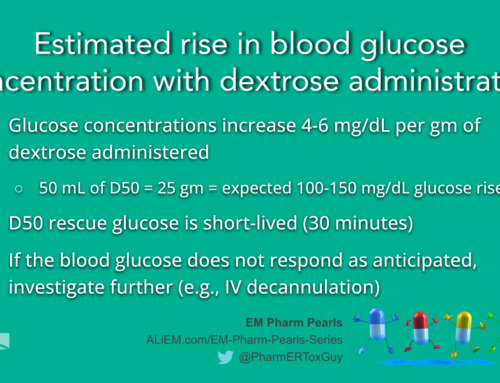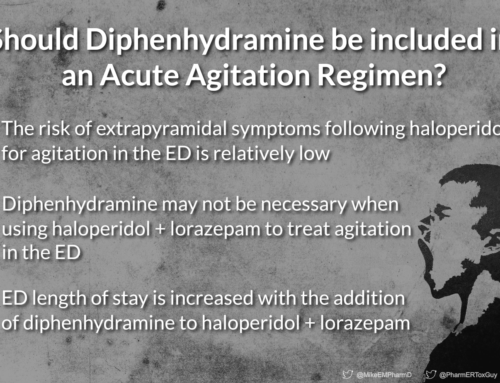The ability to safely and effectively sedate agitated patients in the emergency department (ED) is paramount to provide prompt medical care and protect ED staff. Intravenous (IV) antipsychotics are frequently utilized, instead of other routes, given their more rapid onset of action. Similar to haloperidol, olanzapine can be used safely via the IV route despite both being FDA-approved for intramuscular (IM) administration only.
What is the adverse event profile for IV olanzapine when administered for agitation in the ED?
The table below summarizes the primary data evaluating IV olanzapine in the ED [1-5]. While IV olanzapine is a safe option for some agitated patients, some of these studies report a higher risk of respiratory complications or respiratory depression with the IV route compared to IM olanzapine or other IV treatment options. An Annals of Emergency Medicine commentary argues IV olanzapine might not be necessary for non-emergent cases of agitation or non-agitation indications and the IM route may suffice [6].
| Study | Olanzapine Dose | Adverse Event Rate – Olanzapine | Adverse Event Rate – Comparators | Notes |
|---|---|---|---|---|
| Chang 2013 (N=336) | 10 mg | 8.3% | IV Droperidol: 10.7% Placebo: 15.7 % | |
| Martel 2016 (N=713) | 1.25-20 mg | Minor: 11.4% Major: 2.6% | N/A | Adverse events were respiratory complications; 7 patients intubated |
| Taylor 2017 (N=92) | 5-10 mg | 20% | IV Midazolam + Droperidol: 22% IV Droperidol: 16.2% | |
| Yap 2017 (N=92) | 10 mg | 21.4% | IV Midazolam + Droperidol: 20.6% IV Droperidol: 6.7% | Methamphetamine-induced agitation |
| Cole 2017 (N=784) | 1.25-20 mg | 3.7% | IM olanzapine: 2.0% | Adverse events were respiratory depression |
Table: Adverse Events from IV Olanzapine for Agitation in the ED [1-5]
Treatment of agitated patients in the ED can be complex. Respiratory complications after medication administration may be related directly to the medication(s), the reduction of sympathetic drive, or both. All agitated patients should be monitored after receiving medications for sedation. The exact time course of this monitoring is not known and likely medication specific. Patients at high risk of neurologic, cardiovascular, or hemodynamic compromise should be monitored even more closely. This could include an ECG, pulse oxygenation, vital signs, and direct observation, as appropriate based on the patient-specific factors.
Bottom Line
Medication selection for treating agitation in the ED requires thoughtful consideration of factors such as onset time (read more about “Onset of IM Medications for Severe Agitation“), duration, adverse events, and patient-specific variables. IV olanzapine is an option and monitoring should be commensurate with the situation and medication(s) chosen.
For further information, please read this in-depth literature review of IV olanzapine for the management agitation [7].
Want to learn more about EM Pharmacology?
Read other articles in the EM Pharm Pearls Series and find previous pearls on the PharmERToxguy site.
References
- Chan EW, Taylor DM, Knott JC, Phillips GA, Castle DJ, Kong DCM. Intravenous droperidol or olanzapine as an adjunct to midazolam for the acutely agitated patient: a multicenter, randomized, double-blind, placebo-controlled clinical trial. Ann Emerg Med. 2013;61(1):72-81. doi: 10.1016/j.annemergmed.2012.07.118. PMID: 22981685.
- Martel ML, Klein LR, Rivard RL, Cole JB. A large retrospective cohort of patients receiving intravenous olanzapine in the emergency department. Acad Emerg Med. 2016;23(1):29-35. doi: 10.1111/acem.12842. PMID: 26720055.
- Taylor DM, Yap CYL, Knott JC, et al. Midazolam-droperidol, droperidol, or olanzapine for acute agitation: a randomized clinical trial. Ann Emerg Med. 2017;69(3):318-326.e1. doi: 10.1016/j.annemergmed.2016.07.033. PMID: 27745766.
- Yap CYL, Taylor DM, Knott JC, et al. Intravenous midazolam-droperidol combination, droperidol or olanzapine monotherapy for methamphetamine-related acute agitation: subgroup analysis of a randomized controlled trial. Addiction. 2017;112(7):1262-1269. doi: 10.1111/add.13780. PMID: 28160494.
- Cole JB, Moore JC, Dolan BJ, et al. A prospective observational study of patients receiving intravenous and intramuscular olanzapine in the emergency department. Ann Emerg Med. 2017;69(3):327-336.e2. doi: 10.1016/j.annemergmed.2016.08.008. PMID: 27823873.
- Isbister GK. Droperidol or olanzapine, intramuscularly or intravenously, monotherapy or combination therapy for sedating acute behavioral disturbance. Ann Emerg Med. 2017;69(3):337-339. doi: 10.1016/j.annemergmed.2016.09.021. PMID: 27974168.
- Khorassani F, Saad M. Intravenous olanzapine for the management of agitation: review of the literature. Ann Pharmacother. 2019;53(8):853-859. doi: 10.1177/1060028019831634. PMID: 30758221





